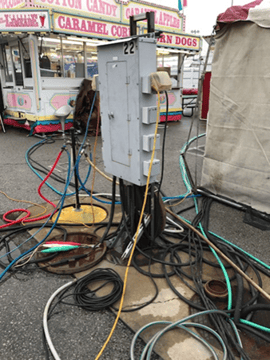"Should we buy a portable power solution or build our own?"
It’s a question that’s been around almost as long as the need for temporary power distribution.
Whether you require power for an event, a job site, a refinery, or a power generation facility, there are certain aspects you need to consider before deciding to build your own or buy a professionally designed and manufactured temporary power distribution solution.
Key factors you might focus on when looking into temporary power units are time and money savings, ease of use and portability on site, and safety.
In this post, we'll be focusing on safety and liability.
------------
Safety should be at the forefront of everyone’s mind while on the job. This is particularly true when thinking about any type of power solution or tool. The risks associated with faulty electrical equipment are far too great to ignore in regards to both personal safety and the liability that is incurred when an accident happens.
When you build your own unit, you may put it together using parts that are all listed by an NRTL, but that does not ensure that the PDU you are constructing will be up to those same rigorous standards. Owning an NRTL listed distribution center ensures that you have a safe product that has been tested under demanding conditions by a respected regulatory body. Besides the obvious point that having an NRTL-listed PDU better safeguards your employees from potential dangers, a professionally-built PDU insulates the company from potential liability if an accident were to occur. Also worth considering is that the engineers that make professional power distribution solutions are required to have and use the National Electric Code (NEC) book and all the national standards when designing this type of equipment.
Also worth considering is that the engineers that make professional power distribution solutions are required to have and use the National Electric Code (NEC) book and all the national standards when designing this type of equipment.
A trained electrical engineer who knows the NEC code book well will design equipment with electrical systems designed for superior safety not just with the mindset of getting power from point A to point B. Of particular importance are articles 406.9 (Receptacles in Damp or Wet Locations), 525.22 (Portable Distribution or Termination Boxes), and 590 (Temporary Installations).
Another advantage of an engineered solution is that it can help you stay compliant with Occupational Safety and Health Administration (OSHA) regulations. For purposes of temporary power, regulations 1926.404 and 1926.405 - which deal with wiring design, protection, wiring methods, components, and equipment for general use - are of significance.
 Other ratings that can be of critical importance in certain situations (particularly when using power distribution units in outdoor or wet location settings) are those put forth by the National Electrical Manufacturers Association (NEMA.) NEMA provides industry-wide standards for many electrical products and components that help consumers decide what kind of product is needed for certain jobs. Professionally designed and manufactured equipment can have certain ratings that can better inform you of what type of solution you need. A home built unit can never promise that.
Other ratings that can be of critical importance in certain situations (particularly when using power distribution units in outdoor or wet location settings) are those put forth by the National Electrical Manufacturers Association (NEMA.) NEMA provides industry-wide standards for many electrical products and components that help consumers decide what kind of product is needed for certain jobs. Professionally designed and manufactured equipment can have certain ratings that can better inform you of what type of solution you need. A home built unit can never promise that.
The last point worth considering when thinking about safety is protecting your company from liability. We live in a very litigious world, so when an injury occurs (i.e. electrocution, shock or a kinetic event, cart rolling into a worker) many questions will get asked. The first one will probably be “who manufactured this equipment?” A homemade solution opens the company up to too much liability risk.
-----
John Nouse
John has been involved in the power distribution, power quality, and lighting world for 20 years, working with maintenance/facility teams and engineers to solve problems and promote safety in retail, commercial and industrial spaces.
More from the blog
View All Posts
Workplace Safety
3 min read
| August 21, 2018
Temporary power: Buy vs. build - ease of use
Read More
Workplace Safety
3 min read
| August 7, 2018
Temporary power: Buy vs. build - saving time & money
Read More
Product Quality
3 min read
| October 26, 2017
Top 4 Reasons to Buy American-Made Products
Read MoreSubscribe to blog updates
Stay up-to-date on what's happening at this blog and get additional content about the benefits of subscribing.
